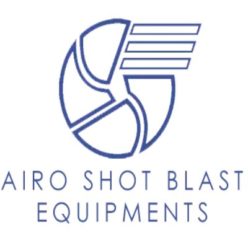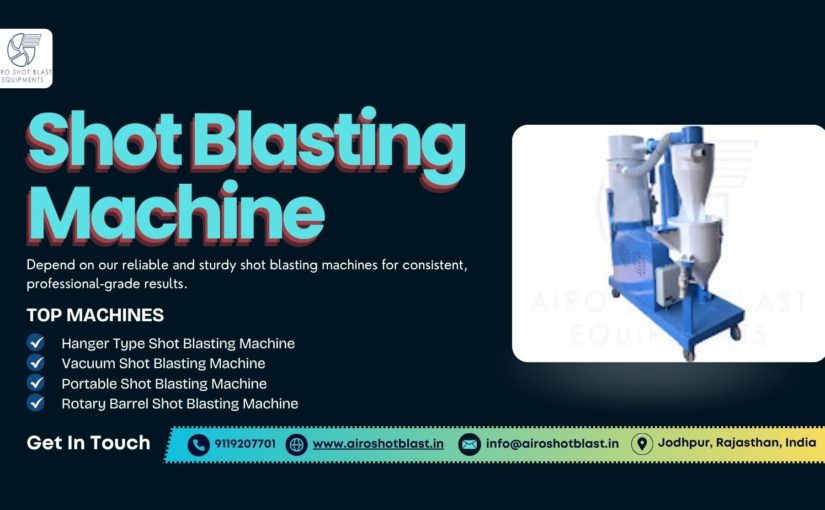The surface preparation industry in India is undergoing a significant evolution, driven by the need for enhanced material durability, improved aesthetic finishes, and compliance with stringent quality standards. At the core of this transformation is the shot blasting machine, an indispensable piece of equipment for a myriad of industrial applications. For businesses considering an investment in this technology, understanding the technical specifications, operational advantages, and diverse applications is paramount. This guide provides a comprehensive, analytical overview, with a specific focus on Airo Shot Blast, a prominent manufacturer in the Indian market, to assist in making an informed purchasing decision.
The Foundational Role of Shot Blasting in Modern Manufacturing
Shot blasting is a process that involves propelling abrasive media at high velocity onto a surface to clean, strengthen, and prepare it. The primary objective is to remove contaminants such as rust, mill scale, and old coatings, while simultaneously imparting a specific surface profile or texture. This process is crucial for enhancing the adhesion of subsequent coatings like paint, powder coat, or thermal spray, thereby extending the lifespan and performance of the final product. Beyond cleaning, shot blasting, particularly a variant known as shot peening, is employed to improve the fatigue resistance of metal components by inducing compressive residual stress on the surface.
This mechanical hardening is vital for parts subjected to high cyclical loads, such as those in the automotive, aerospace, and defense sectors. The efficacy of the process is directly tied to the type of machine, the abrasive media used, and the precise control of blasting parameters.
Dissecti the Key Components of a Shot Blasting System
A complete shot blasting system is an integrated unit, meticulously engineered to perform its function efficiently and safely. A thorough understanding of its core components is essential for evaluating machine quality and performance.
- Blast Wheel: The heart of the machine, the blast wheel, is responsible for accelerating the abrasive media. High-efficiency blast wheels, often dynamically balanced and constructed from wear-resistant materials like high-chrome alloy, are crucial for achieving high kinetic energy transfer and consistent performance. The number and placement of these wheels are calibrated based on the size and geometry of the workpieces to ensure comprehensive coverage and uniform treatment.
- Blast Cabinet: This is the sealed enclosure where the blasting process takes place. A robust cabinet, lined with durable manganese steel (11-14% manganese) or other wear-resistant liners of a minimum 20 mm thickness, is non-negotiable for longevity. The liners are designed to be easily replaceable, minimizing maintenance downtime.
- Abrasive Handling and Recycling System: The system includes a bucket elevator, a separator, and a hopper. The bucket elevator lifts the spent media and contaminants to the separator. The separator is a critical component, utilizing a precise air wash system to remove dust and fines, ensuring only clean, reusable abrasive media is returned to the blast wheel. This recycling process is fundamental to reducing operational costs and maintaining consistent blasting quality.
- Work Handling Mechanism: The mechanism for presenting the workpiece to the blast stream is a defining feature of different machine types. This can range from rotary tables and overhead hangers to roller conveyors and tumble belts, each suited for specific component shapes and production volumes.
- Dust Collection System: An efficient dust collector is not merely a regulatory requirement; it is an integral part of a functional shot blasting machine. A well-designed system, typically a fabric bag type with a high-quality filter medium (e.g., 700 GSM), captures dust-laden air from the cabinet. A mechanical or pneumatic shaking system for the filter bags ensures the continuous removal of accumulated dust, maintaining the system’s efficiency and a clean working environment.
A Spectrum of Shot Blasting Machines for Diverse Applications
The market offers a wide variety of shot blasting machines, each designed to optimize performance for specific industrial needs. The selection of the correct machine type is contingent upon the size, shape, material, and required production volume of the components.
- Tumble Type Machines: Ideal for processing small-to-medium-sized parts in batches, such as forgings, castings, and automotive components. The tumbling action ensures that all surfaces of the parts are exposed to the blast stream, providing a uniform finish.
- Hanger Type Machines: These machines are designed for heavy, large, or irregularly shaped components that cannot be tumbled. Components are suspended from a hook or hanger and rotated as they pass through the blasting zone. This configuration is widely used in the foundry, forging, and heavy fabrication industries for cleaning complex parts.
- Table Type Machines: Featuring a rotating table, these machines are suitable for cleaning flat or round components that require single-pass treatment. They are particularly effective for castings and forgings that must be processed individually. Swing table variants allow for simultaneous loading and blasting, enhancing productivity.
- Roller Conveyor Machines: Engineered for long structural profiles such as steel plates, angles, pipes, and beams, these systems are a cornerstone of the steel and shipbuilding industries. They automate the cleaning and descaling of large materials, ensuring a consistent surface finish for subsequent processes like welding and coating.
- Portable Blasters: Designed for on-site surface preparation and maintenance tasks, these compact, pneumatically-operated units are highly versatile. They are used for localized rust removal, tank cleaning, and preparing surfaces for repair work in the field.
See more – https://buymeacoffee.com/londonyashl/portable-shot-blasting-machines-indian-market-growth-2025
The Airo Shot Blast Advantage: An Analytical Perspective
Airo Shot Blast has established itself as a significant player in the Indian market by offering a comprehensive range of solutions. Our reputation is built on a commitment to robust design, engineering precision, and a deep understanding of our clients’ specific needs. We recognize that a machine is a long-term investment, and as such, we focus on delivering not just a product, but a complete solution that includes installation, operator training, and reliable post-sales support.
Our machines are engineered to thrive in the demanding conditions of Indian industrial environments. We utilize high-grade materials to construct our equipment, from the manganese steel liners in our blast cabinets to the precision-ground EN-grade drive shafts in our blast wheels. Each component is subject to stringent quality control, including dynamic balancing of rotors and a 60-minute on-load test for every blast wheel, to ensure unmatched durability and operational safety.
Furthermore, our systems are designed with energy efficiency in mind, a critical factor for Indian businesses facing rising electricity costs. Features such as optimized blast wheel designs and efficient dust collection systems with low power draw contribute to a lower total cost of ownership over the machine’s lifecycle. We also provide genuine, economical, and easily replaceable spare parts, mitigating potential downtime and simplifying maintenance schedules. Our expert team offers custom-built solutions to address unique industrial challenges, ensuring that every client receives a machine perfectly tailored to their specific application, whether it’s for descaling, shot peening, or surface finishing.
Concluding with a Prudent Purchase Strategy
Selecting a shot blasting machine is a strategic decision that impacts productivity, quality, and long-term operational costs. For a discerning buyer in India, the process must go beyond a simple price comparison. We advocate for a multi-faceted evaluation that considers the following:
- Application and Component Profile: A precise analysis of the components to be blasted, including their size, weight, and material, is the foundational step. This determines the most suitable machine type (e.g., tumble, hanger, or roller conveyor).
- Required Production Throughput: Assess the volume of parts to be processed per shift or day. This will guide the selection of a machine with the appropriate number of blast wheels and automation features (e.g., automatic loading and unloading).
- Machine Durability and Build Quality: Scrutinize the materials used in the machine’s construction, especially the wear-prone components like liners and blast wheel parts. Opting for heavy-duty, wear-resistant materials is a wise investment that reduces future maintenance expenses.
- Operational Costs: Beyond the initial purchase price, consider the long-term costs associated with electricity consumption, abrasive media usage, and spare parts. An energy-efficient machine with an effective abrasive recycling system will provide significant savings over time.
- After-Sales Support: The availability of local service engineers, genuine spare parts, and a comprehensive annual maintenance contract (AMC) is crucial. A machine, no matter how advanced, is only as good as the support that backs it.
By meticulously evaluating these factors, buyers can confidently choose a shot blasting solution that not only meets their current needs but also provides a scalable, efficient, and reliable asset for their operations. We, as Airo Shot Blast, are committed to providing the machinery and expertise necessary to help Indian industries achieve their surface preparation goals with unparalleled precision and efficiency.

